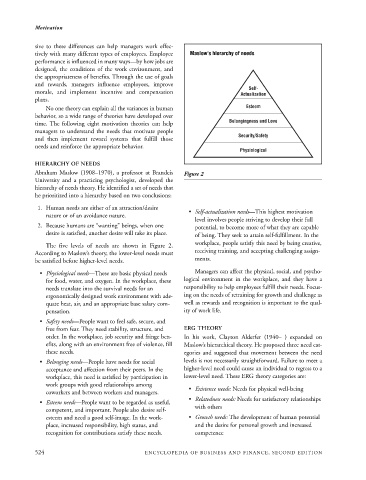Page 547 - Encyclopedia of Business and Finance
P. 547
eobf_M 7/5/06 3:15 PM Page 524
Motivation
sive to these differences can help managers work effec-
tively with many different types of employees. Employee Maslow's hierarchy of needs
performance is influenced in many ways—by how jobs are
designed, the conditions of the work environment, and
the appropriateness of benefits. Through the use of goals
and rewards, managers influence employees, improve
Self-
morale, and implement incentive and compensation Actualization
plans.
No one theory can explain all the variances in human Esteem
behavior, so a wide range of theories have developed over
Belongingness and Love
time. The following eight motivation theories can help
managers to understand the needs that motivate people
Security/Safety
and then implement reward systems that fulfill those
needs and reinforce the appropriate behavior.
Physiological
HIERARCHY OF NEEDS
Abraham Maslow (1908–1970), a professor at Brandeis Figure 2
University and a practicing psychologist, developed the
hierarchy of needs theory. He identified a set of needs that
he prioritized into a hierarchy based on two conclusions:
1. Human needs are either of an attraction/desire
• Self-actualization needs—This highest motivation
nature or of an avoidance nature.
level involves people striving to develop their full
2. Because humans are “wanting” beings, when one potential, to become more of what they are capable
desire is satisfied, another desire will take its place. of being. They seek to attain self-fulfillment. In the
workplace, people satisfy this need by being creative,
The five levels of needs are shown in Figure 2.
According to Maslow’s theory, the lower-level needs must receiving training, and accepting challenging assign-
be satisfied before higher-level needs. ments.
• Physiological needs—These are basic physical needs Managers can affect the physical, social, and psycho-
for food, water, and oxygen. In the workplace, these logical environment in the workplace, and they have a
needs translate into the survival needs for an responsibility to help employees fulfill their needs. Focus-
ergonomically designed work environment with ade- ing on the needs of retraining for growth and challenge as
quate heat, air, and an appropriate base salary com- well as rewards and recognition is important to the qual-
pensation. ity of work life.
• Safety needs—People want to feel safe, secure, and
free from fear. They need stability, structure, and ERG THEORY
order. In the workplace, job security and fringe ben- In his work, Clayton Alderfer (1940– ) expanded on
efits, along with an environment free of violence, fill Maslow’s hierarchical theory. He proposed three need cat-
these needs. egories and suggested that movement between the need
• Belonging needs—People have needs for social levels is not necessarily straightforward. Failure to meet a
acceptance and affection from their peers. In the higher-level need could cause an individual to regress to a
workplace, this need is satisfied by participation in lower-level need. These ERG theory categories are:
work groups with good relationships among
coworkers and between workers and managers. • Existence needs: Needs for physical well-being
• Relatedness needs: Needs for satisfactory relationships
• Esteem needs—People want to be regarded as useful,
with others
competent, and important. People also desire self-
esteem and need a good self-image. In the work- • Growth needs: The development of human potential
place, increased responsibility, high status, and and the desire for personal growth and increased
recognition for contributions satisfy these needs. competence
524 ENCYCLOPEDIA OF BUSINESS AND FINANCE, SECOND EDITION

